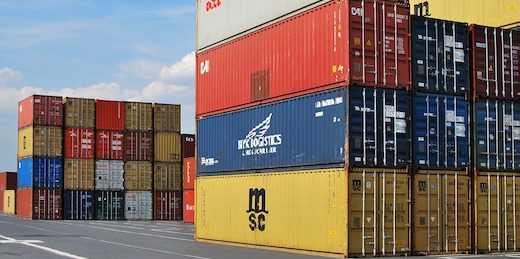The article titled “Trumpian Trade Wars threaten the GCC” appeared in The National’s print edition on 26th July, 2018 and is posted below. Click here to access the original article.
Trumpian Trade Wars threaten the GCC
We are witnessing the demise of multilateralism and rule-based international cooperation
The protectionist stance of the current US administration has been evident since US President Donald Trump took office: the ongoing re-negotiation of the North American Free Trade Agreement (Nafta), non-participation in the Trans-Pacific Partnership (TPP), and the tariff hikes – which began with solar panels and washing machines (in January) to the latest threat of potential additional tariffs on $500 billion worth of Chinese exports.
The nationalism-protectionism of “America First” is coupled with an isolationist view of regional and international agreements on trade, investment, climate, human rights and even defence agreements (Nato). We are witnessing the demise of multilateralism and rule-based international cooperation built since the Second World War.
We have entered the phase of Trumpian Trade Wars, from the imposition of steep tariffs on steel and aluminium in early March this year, to the latest (July 6) announcement of a 25 per cent tariff on about $34bn worth of Chinese goods. China, the EU and others have announced retaliatory tariffs, which does not bode well for global trade. The Financial Times estimates that, should countries retaliate, the value of trade covered by the measures and countermeasures resulting from Mr Trump’s trade policies could reach more than $1 trillion (some 6 per cent of world trade), which would derail global growth and recovery in the EU. The escalating economic tension between the US and Europe, after China has already rattled global stock markets, could lead to a financial crisis given the headwinds of monetary policy tightening and geopolitical turmoil.
Why is the US running large trade deficits? The main answer is that the US has a low level of savings compared to the level of investment. The personal savings rate in the US is running around 3.2 per cent compared to the thrifty Chinese rate of about 35 per cent. The US is spending more than the income it generates, running both a fiscal and a current account deficit, attracting capital inflows and borrowing to finance these deficits. The deficits look set to increase given the US fiscal stimulus package and tax cuts passed in 2017, which encourage consumption and imports at a time when the US economy is overheating.
Tariffs on solar panels, steel and aluminium or cars will raise the cost to US businesses and consumers and disrupt global supply chains. A 25 per cent tariff on all cars and parts would raise US consumer prices by $1,400 to $7,000 for high-end vehicles. For the proposed auto tariffs, nearly 98 per cent of the targeted car and truck imports by value would hit key US allies: the European Union, Canada, Japan, Mexico, and South Korea. Trumpian Trade Wars are not only beggar-thy-neighbour policies, they are beggar-thy-allies.
Cars and phones are prime examples of highly globally integrated industries. Many of the goods that the US imports (such as electrical and electronics) are US designed but manufactured in China, Mexico and other countries with an advantage of lower costs, but relatively low value added in global value chains. The profits, however, are made by US businesses like Apple, Amazon and others. Economists look at “trade value added”, but unscrupulous politicians broadcast headline grabbing total trade numbers.
Although the highlighted US-China trade deficit was at $375bn last year, the US runs trade deficits with 102 nations (not just China) and has run deficits since 1975, averaging $535bn per annum since 2000. The trade deficit on goods was $810bn in 2017 but substantially less at $566bn on goods and services: the US is a major exporter of services and tends to run a large services surplus.
The notion that imposing tariffs on Chinese imports would erase US trade deficits is flawed, absent macroeconomic developments and policies that would change the saving-investment gap. On the other hand, trade retaliation might be costly for export-led China and tit-for-tat tariff hikes between the two largest economies of the world would result in slowing global trade, severe disruption of global supply chains, lower investment, derail economic growth and result in a sharp correction of financial markets.
The announcement of a widening of the scope of tariffs signals that US strategy is shifting away from the protection of local industries (solar, steel) based on “national security” to one based on intellectual property and the acquisition of new tech. The wider, more strategic objective is an attempt to prevent China’s declared ambitions of moving up the activity and trade complexity ladder, with higher value tech goods and services, the “Made in China 2025” horizon.
China is inching closer to developing an edge in AI, blockchain, Big Data, FinTech, life sciences (Crispr) and related technologies. Indeed, the EU might join the US to rein in the emergence of China as a tech frontrunner.
With the US imposing tariffs on a variety of goods, trade will be diverted to other countries. Already, China is buying soya beans from Brazil, shifting from the US. China will shift and develop new markets for its exports, reorienting its trade towards the EU, Asia, and the Middle East, leading to lower prices of affected commodities (which could lead to potential retaliation by the EU and Japan). China has other options: it could retaliate through non-tariff barriers to trade rather than imposition of tariffs; raise informal barriers to US investment in China; diminish the flow of investment in US Treasuries; as well as allow a depreciation of the yuan (justified by lower export and overall growth as a result of US tariffs). We could be entering a phase of currency wars.
The bottom line is that growing US trade protectionism will lead to a shift in global trade patterns and international alliances away from the US and the creation of new trade blocs. Already, the EU and Japan have signed a major trade agreement eliminating most tariffs, covering a market of some 600 million people and a third of the global economy.
China is likely to seek a similar free trade and investment agreement with the EU (which is already China’s most important trade partner) and seek strategic partnerships with Germany and other European countries. It will likely also want to join the Trans Pacific Partnership. China will likely accelerate implementation of its Belt & Road initiative leading to a deeper integration of B&R countries into its economy and its global value chains, opening new markets. China will also accelerate and increase its investments in robotics, AI, Blockchain, Big Data, FinTech, and high tech to bring forward its ambitious “Made in China 2025” strategy. The Chinese dragon will not be contained.
What does all this mean for the GCC? The GCC exported $9.4bn of aluminium in 2017, (of which the UAE provided $5.6bn worth, representing 10.1 per cent of world exports) and is the largest exporter to the US after Canada and Russia. Already adversely affected by aluminium tariffs, the region would be additionally hurt by a decline in world trade and world growth which would lower oil prices, and particularly if China were hard-hit.
The GCC’s total trade with China was close to $110bn last year, with the largest export from the region being crude oil, and accounts for more than two thirds of China’s trade with the Middle East.
Given growing US protectionism, the time is right for the GCC to reorient their international trade agreements and pivot towards Asia, including the long delayed Free Trade Agreement with China.






